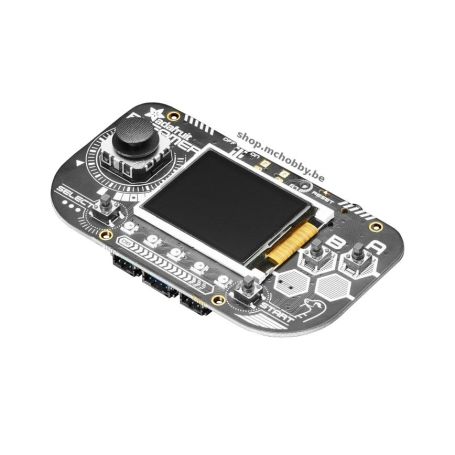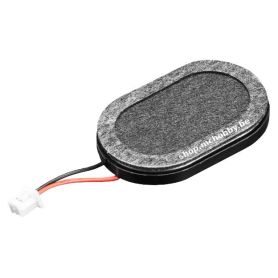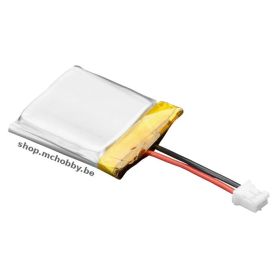Adafruit PyGamer - MakeCode, CircuitPython, Arduino
PyGamer - DIY Gaming development plateform
- ATSAMD51519 @ 120 MHz
- Ram: 192 K
- Flash: 8 MB (QSPI)
- 160 x 128 TFT Color
- Neopixels
- Accelerometer
- Light sensor
Payments are secured by LyraCollect, a French payment collection company.
It is possible to delivered to your home, to a pick-up point or picked up by appointment at MCHobby
We prepare, pack and ship your orders with great respect and care.
A DIY gaming oriented development plateform
The Adafruit PyGamer is another Open Source multi-langage plateform. It can run CircuitPython, MakeCode Arcade or Arduino code to run your own games? Adafruit did developped this board for handheld DIY gaming development and some retro-emulation. It is not a pure retro-emulation gaming console (as ODroid Go and Go Advance) but an all-in-one development board with a lot of possibilities... including gaming!
The PyGamer is powered with ATSAMD51 microcontroler (supported by Arduino IDE), 512KB of Internal Flash and 192KB of RAM. As 512 KB of flash may be too small to store game ressources, Adafruit did added 8 MB of external Flash for file storage (QSPI flash) a lot of space to store sounds, images, maps and many other ressources.
The front of PyGamer fits a 1.8" TFT color display with a resolution of 160x128 pixels. This display have DMA support for fast drawing (updates are incredibly fast) and a dimmable backlight. The analog joystick offers a great directionnal control for X and Y axis. Thanks to the analog feature of this controler, it is possible to have any kind of diagonal movements. The 4 buttons can be fitted with button cap (square-adapter, cap not included) to mimic gaming devices. The PyGamer also includes 2 menu-select + 2 fire-action buttons.
Finally, the front of PyGamer is fitted with 5 NeoPixel LEDs for lightling effect, activity tracking, user feedback, etc.
The back of the PyGamer fits full Feather-compatible header! The user can use any of the FeatherWing expansion to improve the PyGamer plateform. By example: adding an IMU, interacting with real world with Servo/motor controler, Wireless connectivity for multiplayer game, GPS for interacting with localtion... the PyGamer capabilities can be expanded in so many ways. The board also fits 3 STEMMA connectors, 2x 3-pins connector with ADC/PWM capability, 1x 4-pins connectors to connect I2C devices (Grove sensors compatible as well).
The PyGamer also includes a set of sensors with a light sensor (oriented toward the front) and a 3-axis accelerometer (detects taps, fall, shaking). The stereo headphone can be used to produce sounds. As the PyGamer also fits a mono amplifier, you can add a 4-8 Ohms speaker to make it loudy (2W max). The PyGamer will automatically sends audio to the headphone jack when plugged (otherwise, sounds is send to audio amplifier).
The PyGamer can be powered from any of our LiPo You can power the PyGamer from any of our LiPoly batteries but this 350mAh lipo will fit inside the Adafruit acrylic case for PyGamer. The microUSB port can also be used to power the PyGamer (and recharge the Lipo when attached).
Programming the PyGamer
There are many options to program the PyGamer.
- MakeCode Arcade : based on codeblock programming is the easiest way to start game making. With codeblock, you can drag and drop blocks into graphical oriented programming language (like the MicroBit) and then load the game to PyGamer (by activating the disk-drive bootloader).
- Arduino IDE : Arduino is low level, powerful, C programming environment. You can use Adafruit Arcada library to interface with the more easily hardware. This will take care of many of the hardware interaction details for you.
- CircuitPython : the MicroPython based environment can be used to draw graphics, play wave files, display text by using the Python programming language!
Technical detail
- ATSAMD51J19 @ 120MHz with 3.3V logic/power - 512KB of FLASH + 192KB of RAM
- 8 MB Flash QSPI to store files like images, sounds, whatever!
- MicroSD Card Slot to store larger files (or tons of files) when QSPI flash is too small for your needs
- TFT LCD color 160x128 over 1.8" (use its own SPI bus)
- 1x Analog joystick use analog inputs for X and Y position
- 4x buttons for Game Control (square tops)
- 5x NeoPixels for game effect, score display, flash light, etc
- Triple-axis accelerometer (motion sensor)
- Light sensor (reverse-mount so that it points out the front)
- Stereo headphone jack
- Class-D audio amplifier, can drive a mono speaker 4-8 ohms, 2 Watts max
- LiPoly battery port with built in recharging capability
- USB port for battery charging, programming and debugging
- Two female header strips with Feather-compatible pinout so you can plug any FeatherWings in
- JST ports for extra NeoPixels, sensor input, and I2C devices (I2C Grove compatible)
- Reset button
- On/Off switch
Content
For each order, you will receive the PyGamer assembled and tested. Button caps, acrylic case, speaker and battery are not included!
Tutorial
- Primary Guide: Introducing Adafruit PyGamer (Adafruit, English)
Fits in your pocket, is fully Open Source, and can run CircuitPython, MakeCode Arcade or Arduino games you write yourself! - More tutorial from the Adafruit product page (Adafruit, English)












